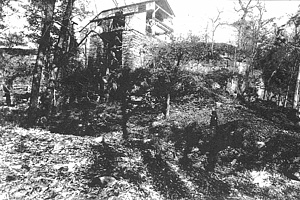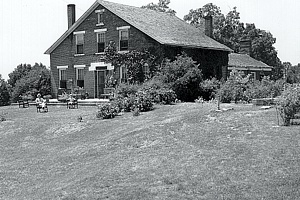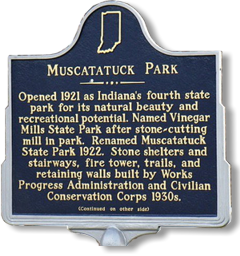


Vinegar Mill State Park
Vinegar Mill State Park was adopted as Indiana's fourth state park in 1921. The Park was named after the early pioneer stone cutting mill located on the banks of the Muscatatuck River .

The name of the park was changed the next year to Muscatatuck State Park. During the park's early history many amenities were added. The park adopted the William Read Home as a bed and breakfast type inn. The state park inn also hosted meals for cabins that were located in the general vicinity. Many reports convey the popularity of the inn and its home cooked meals.
During this same time period the Civilian Conservation Corps (CCC) and the Works Progress Administration (WPA) worked together to build many structures throughout the park.
The workers built the main road leading into the park. They also built bridges, a fire tower and the stone steps at the river overlook area, the Vinegar Mill. Two stone shelters with fire places were also built in this era.
For years the Muscatatuck State Park was a popular destination for visitors. The park was small though and had never charged admission. In 1956 the state reevaluated the facility and decided to use the grounds for its quail and pheasant raising operations. The state created a species re-introduction program that was dropped after 6 years. Biologists warned the state, but regional hunting groups seemed to carry more clout. There are oak barn structures that were built during this era still at the facility.
The state then adopted the park for its Youth Camp initiative in 1962. The state and Gov. Welsh were creating camps specifically for youth. The Muscatatuck Park was the third in this initiative. The first two were for convicted youth, but the Muscatatuck Park camp was to be used by the general public.
Sources reveal that the state was evaluating the park for upgrades during the mid-sixties. After subsequent studies the state opted for not upgrading the park and had a plan to give the park back to the county of Jennings. The park was almost not adopted by the county. After much discussion amongst the local community, they eventually pulled together to manage the facility. In 1967 the Jennings County Parks and Recreation Board was created, and in 1968 the governor signed a bill giving the grounds back to the county to be forever used for recreation.

For almost twenty years the facility experienced low funding and some mis-management, but was showing an increase in family reunions and family picnics.
During the early 1990's the park was successful in securing more funds and correcting some problems. Finally, the park was starting to get support from its local funding leaders. During the late 90's the facility seemed to be coming into its own. The Walnut Grove One-room School was moved to the park in 1991, and the local preservation association received honors from the Indiana Historic Landmarks Foundation for its efforts.
Jennings County Tourism Bureau moved to the William Read Home in 1998, yet had internal issues and left in 2007. The park received a State Historical Marker in 1999; celebrating its history. 2000 marked the Park's most successful year to date. Via the Jennings County Community Foundation and Lilly Endowment Inc., the park renovated the historic Vinegar Mill site. This overlook area is one of the most picturesque sites in the state.
Today the park is visited daily by locals and visitor's alike. Hiking, trail running, and mountain biking are witnessed daily. Increasing numbers of rock climbers get strange looks as they carry in portable pads. Camping has increased to a significant resource. Family reunions and picnics are commonplace. The Muscatatuck Park is a true gem with a significant history. Come in a few more years and help us celebrate our 100th anniversary!